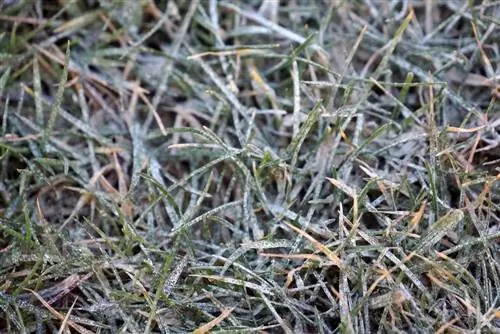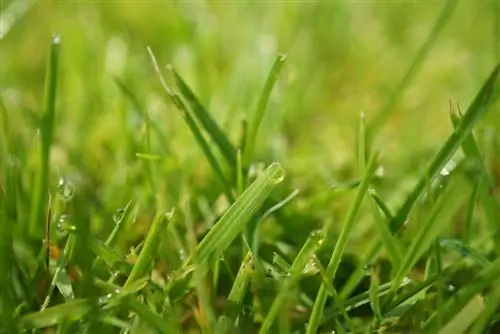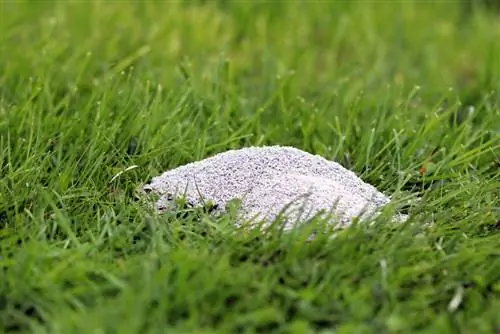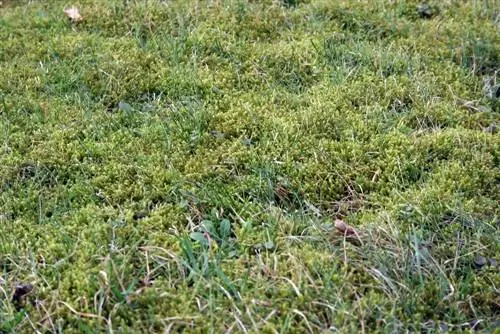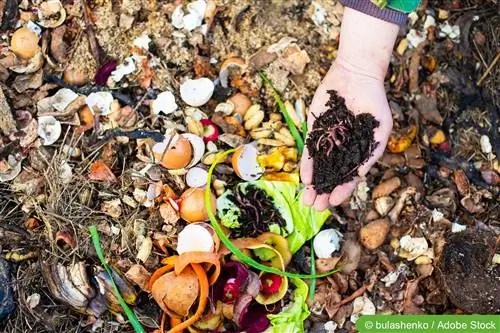- Author admin [email protected].
- Public 2023-12-17 03:39.
- Last modified 2025-01-24 12:45.
In order to ensure a beautiful green garden and a bountiful harvest, fertilizer lime must be used from time to time. This is usually carried out during the actual fertilization measures and must not be used as the only fertilizer alternative. The lime fertilizer only prepares the soil for regular fertilization, which should take place a few weeks later. If a soil is too acidic, it needs lime to become neutral again. However, if too much lime is used, humus is broken down. It is therefore important to observe exact quantities when fertilizing with lime.
Why fertilize with lime
Lime neutralizes the pH value in the soil, but only if it is used specifically and fairly sparingly. But then many successes can be achieved. Acidification of the soil, which occurs gradually over the years, can be prevented if lime fertilizer is supplied every now and then, not every year. The lime also binds clay present in the earth and, last but not least, promotes the activity of microorganisms. If lime fertilization is followed by a nutrient-rich fertilizer, the plants can absorb the nutrients better. By combining the lime with the clay crumbs, the overall soil structure is improved, which also results in better storage of air and water. This also allows the earth to warm up more quickly in spring and the ground does not become muddy as quickly.
Tip:
If too much lime is fertilized, the soil loses humus. At first a lot of nutrients are released, but over time the soil becomes depleted and the storage capacity for additional nutrients, air and water decreases. Therefore, you should always pay attention to the correct dosage when fertilizing.
Identifying acidic soil

Many laboratories offer to analyze the condition of your own garden soil for little money. To do this, soil samples are taken from various places and sent to the selected laboratory. Based on the values resulting from this, the hobby gardener can see whether the soil is too acidic and should therefore be subjected to lime fertilization. But different plants can also indicate whether the soil in the garden bed or lawn is acidic. If the following plants grow in different places in the garden, the soil is too acidic and action should be taken:
- Hare and sorrel
- Field Horsetail
- Pansies
- Sorrel
- Dog Chamomile
- Growth disorders on garden plants are also an indication
- young, yellow leaves
- dried tips on young shoots
- Blossom rot on tomatoes
- brown spots in the flesh of apples
Tip:
If you don't want to send a soil analysis for confirmation, you can also examine the soil yourself using a test set from a well-stocked retailer. However, this only provides a rough assessment of the soil condition.
Consider plant requirements
Not every plant in the garden is unhappy with slightly acidic soil. Therefore, you should not fertilize the entire garden with lime, but rather pay attention to the different needs of the individual plants. Vegetable beds and lawns definitely need regular lime fertilization, as do flower beds with perennial plants. Moorland plants, such as rhododendrons or hydrangeas, summer heather and camellias, do not tolerate any lime.
The right dosage
The correct dosage is important in order not to overcalcify the soil and thus harm the plants rather than help them. It is therefore important for every good hobby gardener to know what the garden soil needs. Since many private and state-funded laboratories already offer soil analysis, which is not expensive, you should definitely take advantage of this. This is the only way to detect when the soil falls below the pH limit of 5.5 to become acidic. Then you can dose and fertilize with lime as follows:
- carry out maintenance lime if the limit values are slightly undershot
- To do this, sprinkle around 150 grams of carbonated lime on one square meter every three years
- If the values are significantly below these values, more must be spread
- raise the pH value in sandy soils
- 250 grams per square meter are required for one step
- Clay soils even need twice as much to increase the pH value by one step
- Clay soils are ideally fertilized with quicklime
Tip:
A lot of lime is needed per square meter, but since the soil is very acidic, there is no point in applying the entire amount of lime required in one go. In such a case, it is better to fertilize with lime on two dates about six months apart and to take another soil sample after about another six months.
Lime fertilizer for the lawn
The lawn can also use lime fertilization every now and then, as the soil can become acidic due to too much moisture or backwater. Then the lawn also turns yellow and loses its rich green. But it should always be borne in mind that clover, for example, is also very fond of lime and therefore clover could spread on the beautiful, well-kept lawn. It is therefore advisable not to lime the lawn too often and to ensure that the pH value is below 5.5. Anything above this is good and the floor does not need to be limed. When liming your lawn, you should therefore proceed as follows:
- scarify before fertilizing
- don't calculate with “good luck” and follow the quantity guidelines
- do not give lawn fertilizer at the same time
- There should be several weeks between different fertilizer applications
Tip:
Whether for applying lime to the lawn or to the garden bed, it is advisable to use a spreader. This guarantees that the same amount of lime is applied to every part of the floor. If you don't want to buy such a spreader, you can also find one for daily rental in well-stocked garden shops.
The right time
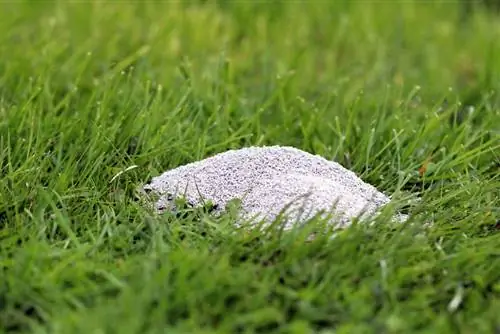
Spring is the ideal time to lime the garden beds and lawn. But several aspects should be taken into account here:
- the ground must be dry
- If lawns or perennial beds are limed, the sky should be overcast
- Sunlight can burn the roots of plants
- do not lime at the same time as adding manure
- because this is how the nitrogen, which is important for plants, escapes into the air
- If the spring date was missed, you can still fertilize with lime in the fall
Overview of various lime fertilizers
Lime is a calcium compound that occurs naturally in many different types of rock. Most commercially available lime fertilizers are based on the raw material calcium carbonate. The following lime fertilizers can be purchased commercially and are ideal for lime fertilization of garden beds and lawns:
Rock flour
- In addition to carbonated lime, it also contains potassium and magnesium
- can be mixed with compost
- pure lime fertilization is not necessary
Garden lime
- suitable for autumn and winter
- ground limestone, often poorly soluble
Brightlime and slaked lime
- mostly used in agriculture on heavy soils
- for your own garden only use in very loamy soil
lime marl
ideal for sandy soils
Algae limestone
- is made from coral deposits
- is particularly suitable for fertilization in spring and summer
Conclusion
Fertilization with lime should only be carried out when it is really necessary, and that is not the case every year. It is therefore important to have the soil analyzed for its pH value and, based on the result, decide whether or not lime should be fertilized. However, lime fertilization never replaces regular fertilization with nutrients and should always be administered a few weeks in advance. Fertilizing with lime also strengthens a he althy lawn. But not all plants like neutral soil, which is made possible by lime fertilization. In these cases, fertilization with lime should generally be avoided.

